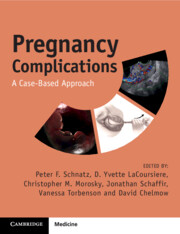Book contents
- Pregnancy Complications
- Pregnancy Complications
- Copyright page
- Contents
- Contributors
- Preface
- Note from the Editor-in-Chief
- Normal Laboratory Values (Conventional Units) []
- Section 1 Antepartum (Early Pregnancy)
- Section 2 Antepartum (Mid-trimester)
- Section 3 Antepartum (Late Pregnancy)
- Case 20 A Patient with Regular Painful Uterine Contractions at 32 Weeks
- Case 21 A 25-Year-Old Presents at 22 Weeks’ Gestation Leaking Clear Fluid
- Case 22 A 40-Year-Old at 34 Weeks’Gestation with Worsening Itching
- Case 23 A 25-Year-Old Presents at 30 Weeks’ Gestation Following a Motor Vehicle Accident
- Case 24 A 20-Year-Old Presents at 34 Weeks’ Gestation with Pruritic Abdominal Rash
- Case 25 A 30-Year-Old Presents at 18 Weeks’ Gestation with Severe Right Back and Flank Pain
- Case 26 A 30-Year-Old at 18 Weeks’ Gestation with Fever, Dysuria, Worsening Flank Pain, and Hydronephrosis
- Case 27 A 35-Year-Old with Abdominal Wall Bulge at 24 Weeks’ Gestation
- Case 28 A 30-Year-Old Presents for a Prenatal Visit at 41 Weeks’ Gestation
- Case 29 A 40-Year-Old Presents at 34 Weeks’ Gestation with Absent Fetal Movement
- Case 30 A 25-Year-Old at 36 Weeks’ Gestation Presents with Severe Bilateral Wrist Pain
- Case 31 A 20-Year-Old Presents at 31 Weeks’ Gestation with Severe Abdominal Pain and Constipation
- Section 4 Antepartum (Medical Complications)
- Section 5 Antepartum (Infectious Complications)
- Section 6 Intrapartum/Delivery
- Section 7 Postpartum
- Section 8 Fetal Complications
- Section 9 Placental Complications
- Section 10 Complications of the Cord, Amnion, and Gravid Uterus
- Section 11 Psychosocial Considerations
- Index
- References
Case 20 - A Patient with Regular Painful Uterine Contractions at 32 Weeks
from Section 3 - Antepartum (Late Pregnancy)
Published online by Cambridge University Press: 08 April 2025
- Pregnancy Complications
- Pregnancy Complications
- Copyright page
- Contents
- Contributors
- Preface
- Note from the Editor-in-Chief
- Normal Laboratory Values (Conventional Units) []
- Section 1 Antepartum (Early Pregnancy)
- Section 2 Antepartum (Mid-trimester)
- Section 3 Antepartum (Late Pregnancy)
- Case 20 A Patient with Regular Painful Uterine Contractions at 32 Weeks
- Case 21 A 25-Year-Old Presents at 22 Weeks’ Gestation Leaking Clear Fluid
- Case 22 A 40-Year-Old at 34 Weeks’Gestation with Worsening Itching
- Case 23 A 25-Year-Old Presents at 30 Weeks’ Gestation Following a Motor Vehicle Accident
- Case 24 A 20-Year-Old Presents at 34 Weeks’ Gestation with Pruritic Abdominal Rash
- Case 25 A 30-Year-Old Presents at 18 Weeks’ Gestation with Severe Right Back and Flank Pain
- Case 26 A 30-Year-Old at 18 Weeks’ Gestation with Fever, Dysuria, Worsening Flank Pain, and Hydronephrosis
- Case 27 A 35-Year-Old with Abdominal Wall Bulge at 24 Weeks’ Gestation
- Case 28 A 30-Year-Old Presents for a Prenatal Visit at 41 Weeks’ Gestation
- Case 29 A 40-Year-Old Presents at 34 Weeks’ Gestation with Absent Fetal Movement
- Case 30 A 25-Year-Old at 36 Weeks’ Gestation Presents with Severe Bilateral Wrist Pain
- Case 31 A 20-Year-Old Presents at 31 Weeks’ Gestation with Severe Abdominal Pain and Constipation
- Section 4 Antepartum (Medical Complications)
- Section 5 Antepartum (Infectious Complications)
- Section 6 Intrapartum/Delivery
- Section 7 Postpartum
- Section 8 Fetal Complications
- Section 9 Placental Complications
- Section 10 Complications of the Cord, Amnion, and Gravid Uterus
- Section 11 Psychosocial Considerations
- Index
- References
Summary
Preterm labor, marked by cervical changes between 20 0/7 and 36 6/7 weeks’ gestation, is a significant contributor to preterm birth, accounting for 50% of such cases and is associated with increased neonatal mortality and long-term health issues. Understanding preterm labor involves considering diverse factors, including maternal medical history, demographics, and current pregnancy characteristics. Modifiable risk factors such as short interpregnancy intervals and substance use play a role in its onset. Diagnostic tools like transvaginal ultrasonography and fetal fibronectin aid in identifying at-risk individuals. Effective management of preterm labor is a pivotal aspect of obstetric care. Tocolytics, antenatal corticosteroids, and group B streptococcus prophylaxis are integral interventions. Decisions about the mode of delivery include the potential benefits of cesarean delivery in extreme prematurity. This case underscores the importance of vigilant monitoring, timely diagnosis, and intervention in addressing preterm labor, thereby mitigating its adverse effects on maternal and neonatal health.
Keywords
- Type
- Chapter
- Information
- Pregnancy ComplicationsA Case-Based Approach, pp. 61 - 64Publisher: Cambridge University PressPrint publication year: 2025

